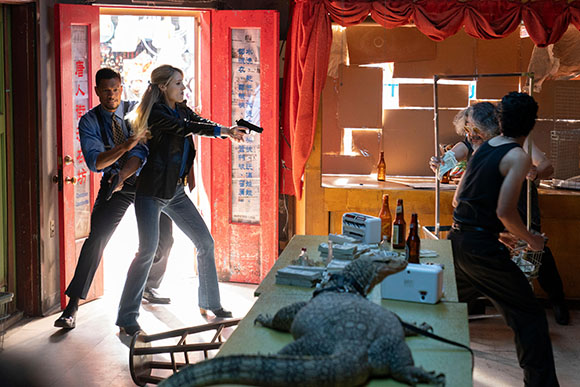published by Post Magazine
The Hulu limited series Interior Chinatown is based on Charles Yu's awards-winning book of the same name, and follows Willis Wu, a background character trapped on a police procedural called ‘Black & White.’ As he is relegated to the background, Willis goes through the motions of his on-screen job, while also waiting tables and dreaming about a world beyond Chinatown. After he inadvertently becomes a witness to a crime, Willis begins to unravel a criminal web in the neighborhood, as well as family's own buried history, while also learning what it feels like to be in the spotlight.
Taika Waititi directed the pilot of the series for 20th Television, which spans 10 episodes. The show stars Jimmy O. Yang, Ronny Chieng, Chloe Bennet, Lisa Gilroy, Sullivan Jones, Archie Kao and Diane Lin.

Tari Segal (pictured) worked as director of photography on the show, which debuted on November 19th. Here, she reflects on the series’ cinematography, which aims to capture the essence of this wild journey, and includes chaotic streets scenes and no-holds-barred Kung Fu fights.
Hi Tari! How did you become involved with this project?
“Mike Berlucci was heading up the show and was looking for a partner to come on-board with him and rotate. I didn't know any of the producers, but after we all met, they really loved what I could bring to the show and they gave me a lot of room and support to lean into various creative styles, and to approach my work in an artful and abstract way to really help support the unique style of storytelling that was asked for in the scripts.”

What were your responsibilities in helping to create the look of the series?
“When I was brought on, they were still developing the look of the fake procedural show ‘Black & White.’ I have a lot of experience with shows of that nature, so I was able to highlight some technical things that we could build upon in a satirical nature. Things such as the traditional ‘walk & talk,’ which you can see in the bullpen of Episode 2, and some typical coverage styles. Procedurals are often shot a certain way because of time and delivery dates, and the need to shoot 21-plus episodes a season. Those challenges, along with network expectations, often shape the camera & lighting approach. We leaned on those ideas, and really exaggerated it with strong backlights and using zoom lenses.”

Can you talk a bit about your camera & lens package?
“We used Alexa 35s from Panavision, along with P vintage primes and C Series anamorphics. We shot several different aspect ratios during the show.”

What would you say was the most challenging scene and why?
“One of the most challenging episodes was 8. I had to create several different commercial looks that emulated whiskey ads, Rolex ads and musicals. Each commercial world had a different look and unique approach. Some were shot on anamorphic lenses, one was shot on an ENG docu-style zoom lens, etc. The most elaborate moment was the Steadicam oner that we designed on a stage with many lighting cues and a pedestal crane. It was a lot of fun and we pulled it all off because of a fantastic crew.”